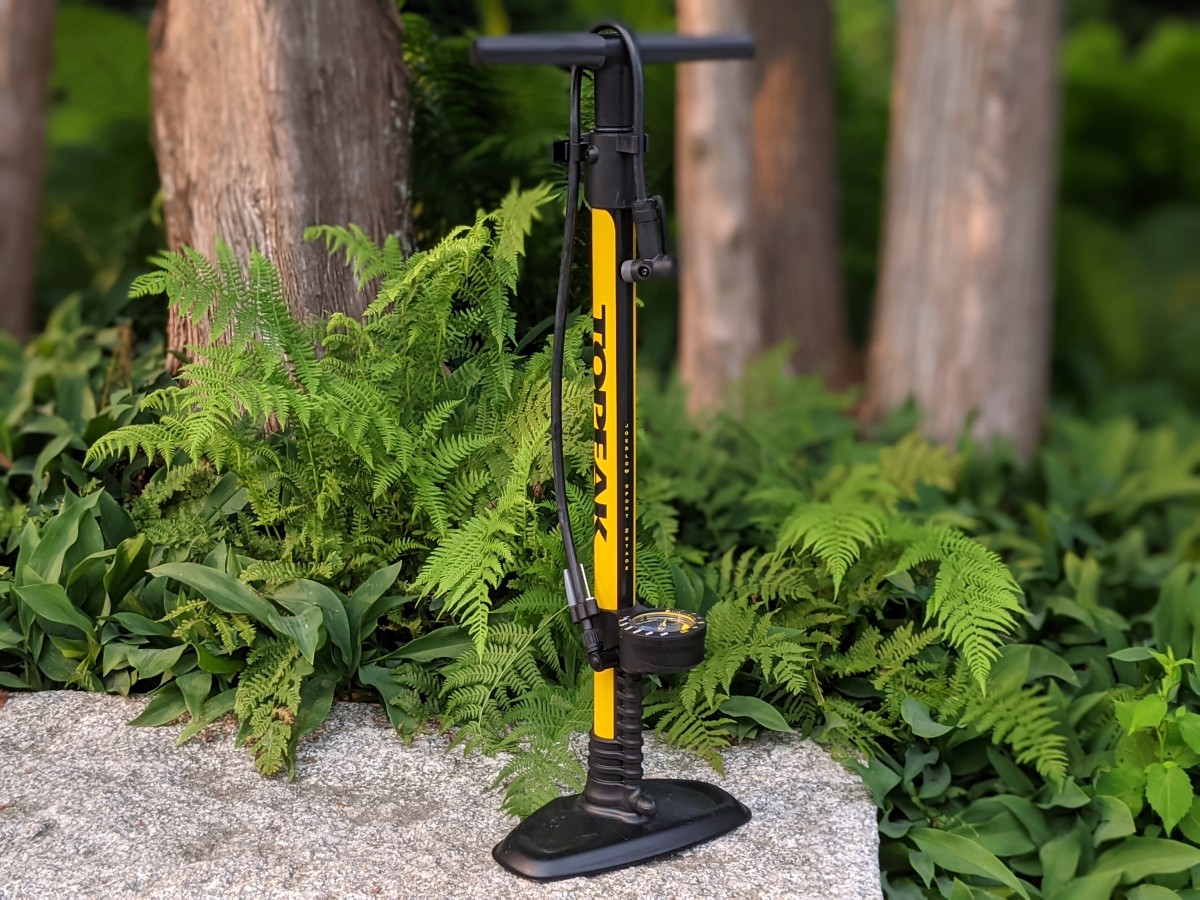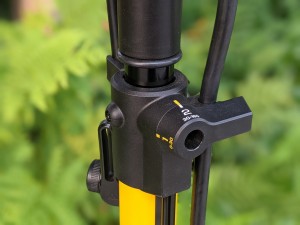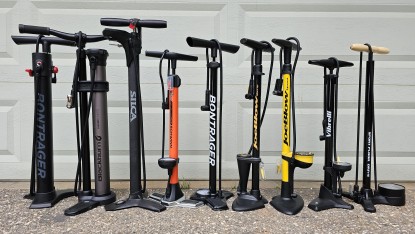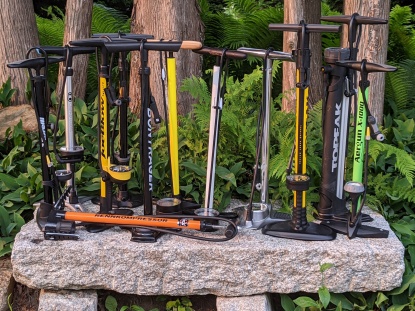Our Verdict
Our Analysis and Test Results
If you want to switch between high-volume and high-pressure quickly and you want to be able to do it fast, the JoeBlow Sport 2Stage is a great choice. Just keep in mind that this pump is tall, so shorter users may struggle to use the full volume of the pump consistently.
Ease of Attachment
Attaching this pump's lock-on chuck is straightforward. Press it down inline with the tire's valve until the valve is covered. Once it's in place, slide the locking handle on the nozzle away from the tire and hammer away. The lock is large and rotates easily, which we can't say for all the pumps in our lineup. It makes a bigger difference than you'd think. All told, we never struggled to get this pump's nozzle in place or keep it attached.
The chuck is compatible with Presta, Dunlop, and Schrader valves, and the double-sided nozzle makes it incredibly easy to switch back and forth; just use one side or the other. The quick flip keeps it at the ready. One side, marked with a P, works with Presta and Dunlop valves; the other is marked with an S for Schrader.
The hose seems high-quality and is pliable, making it easy to move around. It's mounted on a swivel on the right side of the gauge. It does, sort of, rotate a full 360 degrees as advertised, but it struggles to fit around the gauge. That makes it hard to pull the hose straight out in front of the pump. That said, we never ran into a situation where we needed it to be longer or more mobile than it is.
Inflation
The unique aspect of this pump is that you can set it up to accommodate either high-volume tires for mountain biking or high-pressure tires for the road. Its default is Stage 1 for high volume, and that's where it shines. This setting leaves the dial at the top of the pump in its natural position, in line with the shaft. Stage 1 opens both of the pump's barrels to access 715 ccs (cubic centimeters) of air volume, helping you reach 30 PSI (pounds per square inch) with “30% less effort,” according to Topeak.
In our test, it took eight pumps for the 2Stage to inflate a 26" downhill tire from 10 to 30 PSI. The other pumps needed 16 to 30. That's a 100 to 375% increase. If you want to fill up a bunch of fat tires, it's hard to argue with that efficiency. But, it does become harder to press down every pump, so you're still working hard.
The 2Stage didn't do quite as well in our road bike tire inflation test. We switched it to Stage 2 by flipping the switch, setting the pump up to use only one barrel with 258 ccs, and making it easier to compress if you need to crank up the pressure. It took 11 compressions to take our tire from 40 to 80 PSI, according to the gauge. That's higher than the eight odd pumps the best high-pressure pumps needed, but not too shabby.
Keep in mind, though, as we discuss below, the pump's gauge isn't very accurate at higher pressures, so you'll be doing more pumping with road tires if you want to hit your target.
We like the feel of this pump and appreciate the wide, flat, and comfortable handle. Since it's not contoured, it works well no matter your hand size, and the rubber has a nice feel. The base plate doesn't angle towards the body very far, so standing on it with both feet pulls you uncomfortably close to the pump, particularly given its height (29.75 inches). In fact, it's so tall when extended (49 inches) that our 5'5" tester had trouble getting weight over the handle to get a full compression. This wasn't a problem for our 6'2" tester.
With this pump, you get needle and cone adapters, and a secure holder for both is clamped onto the hose. However, there isn't an air bleeding system to precisely lower the pressure if you accidentally overinflate your tires.
Stability
The 2Stage is balanced enough to stand solidly on its own and even to deal with a few knocks. A fairly heavy steel construction keeps its center of gravity low, which helps keep it upright. However, though the base is wide laterally, it doesn't have as much front-to-back stability. There are two points that jut out in front to give it some tip-resistance, but it sways more readily than we'd like.
Again, the base plate doesn't set you up for the best pumping position. If you have both feet on the base, it's uncomfortable, pulling you too close to the handle to have much leverage. The shorter you are, the worse it feels. With one foot on and the other off, it's fine but far from our favorite.
Two crimps at the top of the shaft hold the hose in place and keep the chuck from banging around the pump too alarmingly. One clip is on the same side of the pump as the hose attachment point. The other is centered on the shaft. The hose is short enough that only about 5 inches of the hose and nozzle are left loose, minimizing wear and tear on the chuck. The hose is also short enough that you can clip the nozzle in close to minimize movement without leaving too much slack in the hose.
Accuracy
Accuracy is the biggest weak point for the 2Stage. Again, it's fine at pressures at or below 30 PSI, but this gauge goes up to 160 PSI. That leaves a range of 130 where it doesn't do so well. We're pretty tempted to blame the gauge, but we'll get into that below. First, we'll summarize the results of our accuracy tests.
When we double-checked our tire pressures after pumping a mountain bike tire up to 30 PSI, our independent gauge said they were 1 to 3 PSI below. We got more accurate the more we tried. We can live with that.
When verifying our 40 PSI pressure tests on a road bike tire, the tires were 4 to 5 PSI under-inflated. Not great, but we learned to adjust. By the time we got to 80 PSI, we were off by 5 to 10 PSI. The tires always held less air than the 2Stage led us to believe. That is irksome. Check out the gauge section below for more information.
Gauge
The gauge on the 2Stage is set about 9 inches off the floor, which holds it closer to your eyes without being so high that it throws the pump's balance off. It reads pressure in both PSI and Bar and displays the PSI numbers on the edge of the gauge itself. That keeps them clear of the glare of the glass and makes them very easy to see. The gauge's face itself is about 3 inches across.
The gauge is color-coded as well. The readings up to 30 PSI are yellow, take up half the screen, and mark every single PSI to help you dial in small changes. The rest of the gauge is labeled in white, with numbers labeled in 20 PSI increments from 30 to 160 PSI. Each tick mark on this side marks 5 PSI, and they are very close together.
The detail on the first half of the gauge is cool but not that useful. No one really needs to know if they have 5 PSI in a tire, but you'll sometimes want to hit pressures around 31 or 32, and this gauge makes that hard. The resolution drops starkly after 30 PSI, making it hard to tell if you're pointing to 40, 42, or 45. We think this may be why our higher pressure readings were less accurate, but it probably doesn't explain it all.
The convenient sliding marker does help you keep track of the pressure you want to hit, but it doesn't compensate for the lack of precision in the second half of the gauge.
Should You Buy the Topeak JoeBlow Sport 2Stage?
This is by far the most efficient pump we tested when it comes to inflating high-volume tires. It's a rare specialist. If that's important to you, that alone could make it worth its relatively high price tag. To be able to move that much air and then switch to filling a high-pressure tire is impressive. Other options offer the same volume to pressure switch, but none fill those tires so quickly. You can't buy your time back, and this pump will definitely save you some. If you mostly ride on trails but crank out road rides from time to time and don't mind being patient while you dial in your numbers, the Topeak JoeBlow Sport 2Stage may be the right mix for you.
What Other Bike Pumps Should You Consider?
If you're looking to save some money, the Bontrager Charger is a fraction of the price and provides good pumping performance, although it doesn't fill high-volume tires quite as quickly. If you don't mind pumping a bit more, it's a solid option that won't break the bank.

















